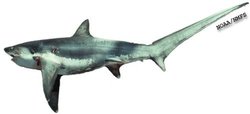Thresher Shark
|
|
| Thresher sharks | ||||||||||||
|---|---|---|---|---|---|---|---|---|---|---|---|---|
| Thintail thresher | ||||||||||||
| Scientific classification | ||||||||||||
| ||||||||||||
| Species | ||||||||||||
|
A. pelagicus |
Thresher sharks are large lamniform sharks of the family Alopiidae. Found in all temperate and tropical oceans of the world, the family contains three species all within the genus Alopias.
Like all large sharks, threshers are slow growing and are therefore threatened by commercial fisheries. Other than for its meat, the sharks are hunted for their liver oil, skin (for leather), and their fins, for use in shark-fin soup.
The genus and family name derive from the Greek word alopex, meaning fox. Indeed the Long-tailed Thresher Shark (Alopias vulpinus) is named the Fox Shark by some authorities.
| Contents |
Physical description
Named for and easily recognised by their exceptionally long, thresher-like tail or caudal fins (which account for 50 percent of their total body length), thresher sharks are active predators; the tail is actually used as a weapon to stun prey. By far the largest of the three species is the thintail thresher (Alopias vulpinus) which may reach a length of 7.6 metres and a weight of 348 kilograms. The bigeye thresher (Alopias superciliosus) is next in size, reaching a length of 4.89 metres; at just 3 metres, the pelagic thresher (Alopias pelagicus) is the smallest.
Thresher sharks are fairly slender, with small dorsal fins and large, recurved pectoral fins. With the exception of the bigeye thresher, these sharks have relatively small eyes. Coloration ranges from brownish, bluish or purplish gray dorsally with lighter shades ventrally.
Habitat and diet
Although occasionally sighted in shallow, inshore waters, thresher sharks are primarily pelagic; they prefer the open ocean, staying within the first 500 metres of the water column. They are also found in coastal waters over continental shelves.
Pelagic schooling fish (such as bluefish, juvenile tuna, and mackerel), squid and cuttlefish are the primary food items of the thresher sharks. They are known to follow large schools of fish into shallow waters. Crustaceans and the odd seabird are also taken.
Behaviour and reproduction
Thresher sharks are solitary creatures which keep to themselves. They do not appear to be a threat to humans. It is known that thresher populations of the Indian Ocean are separated by depth and space according to gender. All species are noted for their highly migratory or oceanodromous habits.
No distinct breeding season is observed by thresher sharks. Fertilization and embryonic development occur internally; this ovoviviparous or live-bearing mode of reproduction results in a small litter (usually 2-4) of large well-developed pups, up to 150 centimetres at birth in thintail threshers. The young fish exhaust their yolk sacs while still inside the mother, at which time they begin feeding on the mother's unfertilized eggs; this is known as oophagy.
Thresher sharks are slow to mature, males reaching sexual maturity between 7-13 years of age and females between 8-14 years in bigeye threshers. They may live for 20 years or more.
See also
- List of fish common names
- List of fish families
- Thresher for other meanings of the word
External link
- FishBase entry on Alopiidae (http://filaman.uni-kiel.de/Summary/FamilySummary.cfm?ID=486)
- MarineBio: Thresher shark, Alopias vulpinus (http://marinebio.org/species.asp?id=284)
| Shark articles | |
|---|---|
| Angel | Basking | Blacktip Reef | Blue | Bull | Carpet | Cat | Cookiecutter | Freshwater | Frilled | Goblin | Gray Reef | Grey Nurse | Great White | Hammerhead | Mako | Megamouth | Nurse | Oceanic Whitetip | Porbeagle | Requiem | River | Sand | Sandbar | Saw | Silky | Sleeper | Smooth dogfish | Thresher | Tiger | Whale (shark) | Whitetip reef | Wobbegong | Zebra / Leopard | |
| Extinct shark species | |
| Megalodon | Cladoselache | Squalicorax |

